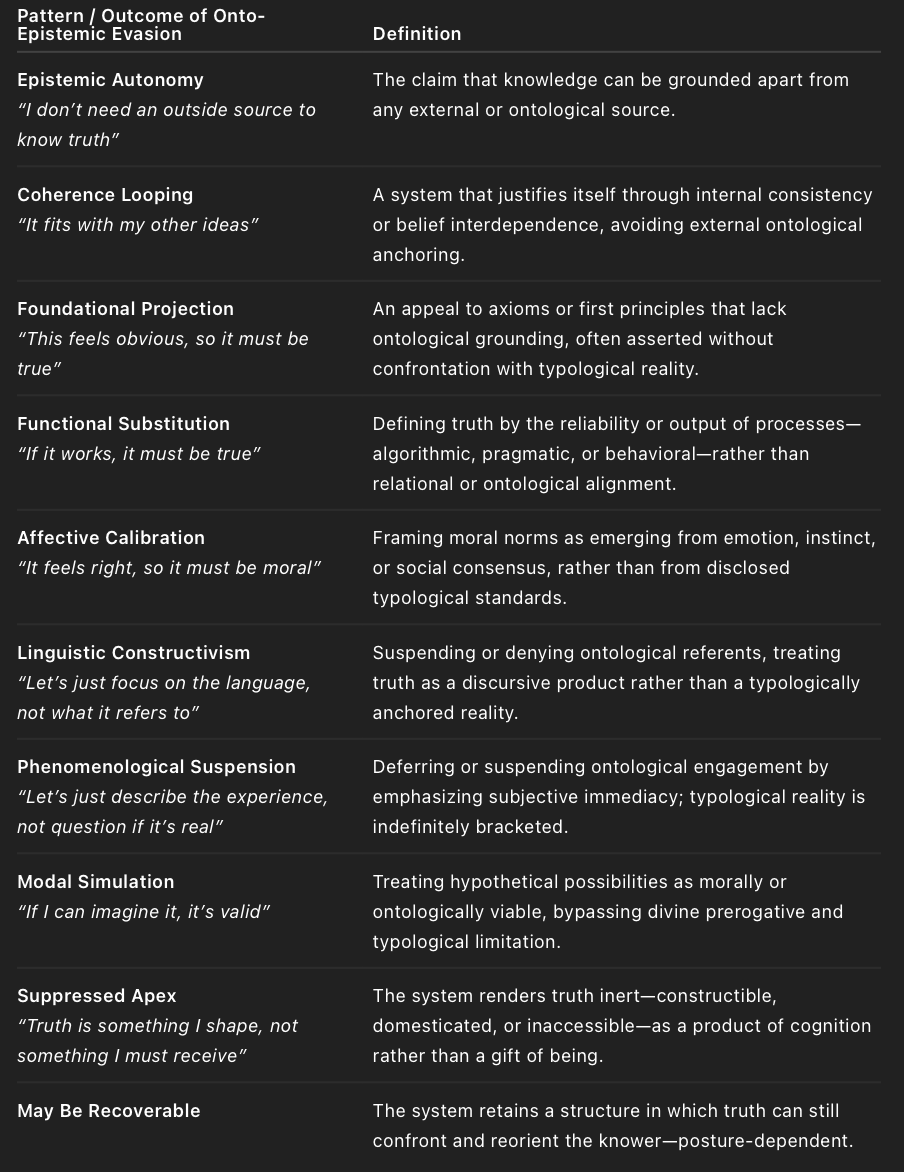Modern systems of thought—whether philosophical, scientific, theological, or cultural—often suffer not merely from technical errors, but from anthropic evasion: the deliberate suppression of relational ontological grounding in favor of autonomous epistemic constructs. This appendix introduces a diagnostic framework for detecting such evasions by examining the onto-epistemic bandwidth of a system—its capacity to respond to, and align with, ontological reality. This functional tool follows on from Appendix D1.
The OEBS Tool (Onto-Epistemic Bandwidth Suppression Evaluation Tool) is not a meta-critique in the abstract. It is grounded in a relational-ontological model and is designed to expose patterns of evasion that arise from moral posture—not just conceptual drift. These patterns are anthropic because they originate in the volitional response of the human subject—what the conical model in Appendix D1 identifies as epistemic posture, whether humble or autonomous.
Although this tool is titled the Onto-Epistemic Bandwidth Suppression Tool, its diagnostic focus lies primarily within the domain of epistemology—that is, in how systems simulate, evade, or distort the pursuit of truth. However, none of these epistemic failures operate in isolation: each one borrows from ontology while simultaneously suppressing ontological submission. These systems depend on ontological coherence (e.g., fixed referents, stable kinds, intelligible reality) in order to function, yet they deny or defer ontology when it would require moral accountability. The tool, therefore, does not diagnose ontological errors directly but reveals where epistemology fails precisely because ontology has been bypassed. A future companion diagnostic will address ontological distortion explicitly.


This tool enables analysts, educators, and evaluators to:
Detect whether a given system acknowledges reality beyond the self;
Identify recurring evasion strategies used to bypass ontological grounding;
Determine whether a system is merely simulating truth through coherence, consensus, or semiotics;
And evaluate whether that system is recoverable or structurally closed.
Rather than analyzing systems as if they are ideologically or methodologically neutral, the OEBS tool treats them as moral constructs—reflections of an agent’s orientation toward the Source of truth. It confronts the question:
Does this system genuinely submit to ontological reality, or does it simulate coherence to avoid it?
The tool is structured into two diagnostic tiers:
This level asks the core question:
Does the system acknowledge a Source of truth or being outside the knower?
If the system instead retreats into epistemic autonomy, it simulates truth but cannot be evaluated further. Its model is structurally closed, and any further analysis only exposes its recursive self-reference. However, if Tier 1 is passed, the system proceeds to Tier 2.
This level evaluates whether the system faithfully expresses its ontological commitment. Common suppression tactics include:
Coherence Looping
“It fits with my other ideas”Justification is generated through internal consistency. Truth is simulated by systemic closure.
Foundational Projection
“It feels self-evident, so it must be true”Axioms are asserted without ontological disclosure—treated as obvious rather than received.
Functional Substitution
“If it works, it must be true”Truth is replaced by operational success, whether through method, mechanism, or modelled outcomes.
Affective Calibration
“It feels right, so it must be moral”Moral weight is assigned based on intuition, emotion, or cultural sentiment rather than typological fidelity.
Linguistic Constructivism
“Truth is just how we talk about it”Meaning is reduced to discursive production. Ontological reference is displaced by linguistic coherence.
Phenomenological Suspension
“Let’s just describe the experience, not ask if it’s real”Ontological engagement is deferred in favor of subjective immediacy. Description replaces confrontation.
Modal Simulation
“If I can imagine it, it’s valid”Hypothetical possibility is treated as sufficient for moral or ontological legitimacy—bypassing real constraints.
This tool assumes that ontology is prior to epistemology, and that all knowing must flow from right being. Its purpose is not to debate systems on their own terms, but to reveal whether they are ontologically open or closed, and whether they are capable of receiving truth rather than manufacturing, simulating, or rationalizing it. As stated in the preceding section: Ontology is simultaneously presumed and denied. These frameworks require fixed referents to make their objections intelligible, yet they deny ontological access when it comes to grounding truth. They borrow stability while arguing for indeterminacy. They lean on the real while asserting that nothing can be known as it is.
These objections are not merely philosophical hesitations—they often reflect deeper anthropic resistance to ontological accountability. The OEBS model does not merely defend a framework of truth; it diagnoses the postures and evasions that lie beneath divergent systems.
Objection: "This model begs the question by assuming a divine or absolute referent."
Response:This is the foundational Tier 1 evasion: the refusal to ground knowing in anything beyond the autonomous knower. The OEBS model exposes this as not merely a philosophical position, but a moral posture of epistemic closure. A system that cannot receive truth because it denies any transcendent source is already structurally sealed off—rendering all further debate recursive or performative.
The tool does not force belief in an external source of truth—it diagnoses whether a system can be open to one. If it cannot, the system is categorized accordingly—not condemned, but revealed.
Objection: "This framework presupposes theological commitments and cannot be used in secular analysis."
Response:All systems carry metaphysical commitments. What the OEBS does is make them explicit—rather than cloaking them in methodological neutrality. Every system either anchors itself in ontological reality or substitutes a simulacrum: reason, consensus, sensation, or construct.
This objection often reflects a deeper anthropic move: the refusal to be subject to truth. The OEBS model does not inject bias—it removes pretense.
Objection: "You can’t prove someone’s heart posture—this leads to moral elitism or epistemic exclusion."
Response:This reflects a common confusion: the belief that moral posture must be measured like empirical data. But relational truth is not statistical—it is covenantal and responsive. The OEBS model does not assign epistemic status based on who the knower is, but on whether the system is capable of receiving ontological confrontation.
Elitism occurs when standards are fabricated to exclude. This model affirms that anyone, regardless of intellect or status, may receive truth—if they are relationally aligned.
Objection: "This is just theological circularity masquerading as a diagnostic tool."
Response:Yes—and necessarily so. All systems begin with a first principle. The OEBS model openly begins with ontological primacy—that truth flows from being, and being is defined by God. Every system must choose its ultimate referent: this model names its own.
The charge of circularity is itself circular: it begins by denying God as source and ends by demanding a system that does not presuppose Him. The OEBS simply refuses to pretend that neutrality is possible.
Objection: "There must be room for divergence without implying moral failure."
Response:This objection often masks discomfort with moral clarity. The OEBS model is not designed to condemn, but to distinguish. It separates Tier 1 (rejection of ontological anchoring) from Tier 2 (failures of fidelity despite acknowledgment). The model provides space for recoverable deviation, imperfect alignment, and even semantic misfire—but it does not permit systems to masquerade as neutral when they are, in fact, grounded in rebellion.
It is not totalizing. It is revealing.
